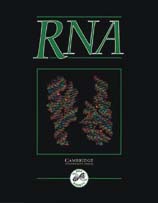The case against the involvement of the NMD proteins in programmed frameshifting
Published online by Cambridge University Press: 27 December 2000
Abstract
The complexity of the nonsense-mediated decay (NMD) system makes it difficult to study by comparing the expression of various single reporter constructs. The known effects of the NMD genes include a reduction both in mRNA stability (reviewed by Czaplinski et al., 1999) and in the efficiency of translational initiation (Muhlrad & Parker, 1999) of nonsense-containing plasmids as well as an apparent increase in the efficiency of translational termination as evidenced by increased readthrough of nonsense mutations (Bidou et al., 2000; Maderazo et al., 2000). The single reporter system can not distinguish among these effects and inference is required to determine which mechanism underlies any observed phenotypic effect on gene expression. It is particularly problematic to differentiate the effects of translation initiation accuracy from putative effects on translational frameshifting. The dual reporter system used in our work isolates the effect of translational frameshifting from effects on mRNA stability, initiation or termination. Much is made by Dinman et al. of the relative effects of various mutations, yet it remains unclear whether these are fundamental differences or simply differences in phenotypic strength of the various mutations.
Information
- Type
- DIVERGENT VIEWS
- Information
- Copyright
- © 2000 RNA Society
- 8
- Cited by

